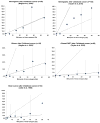Second solid cancers after radiation therapy: a systematic review of the epidemiologic studies of the radiation dose-response relationship
- PMID: 23102695
- PMCID: PMC3816386
- DOI: 10.1016/j.ijrobp.2012.09.001
Second solid cancers after radiation therapy: a systematic review of the epidemiologic studies of the radiation dose-response relationship
Abstract
Rapid innovations in radiation therapy techniques have resulted in an urgent need for risk projection models for second cancer risks from high-dose radiation exposure, because direct observation of the late effects of newer treatments will require patient follow-up for a decade or more. However, the patterns of cancer risk after fractionated high-dose radiation are much less well understood than those after lower-dose exposures (0.1-5 Gy). In particular, there is uncertainty about the shape of the dose-response curve at high doses and about the magnitude of the second cancer risk per unit dose. We reviewed the available evidence from epidemiologic studies of second solid cancers in organs that received high-dose exposure (>5 Gy) from radiation therapy where dose-response curves were estimated from individual organ-specific doses. We included 28 eligible studies with 3434 second cancer patients across 11 second solid cancers. Overall, there was little evidence that the dose-response curve was nonlinear in the direction of a downturn in risk, even at organ doses of ≥60 Gy. Thyroid cancer was the only exception, with evidence of a downturn after 20 Gy. Generally the excess relative risk per Gray, taking account of age and sex, was 5 to 10 times lower than the risk from acute exposures of <2 Gy among the Japanese atomic bomb survivors. However, the magnitude of the reduction in risk varied according to the second cancer. The results of our review provide insights into radiation carcinogenesis from fractionated high-dose exposures and are generally consistent with current theoretical models. The results can be used to refine the development of second solid cancer risk projection models for novel radiation therapy techniques.
Published by Elsevier Inc.
Conflict of interest statement
Conflicts of interest: None to declare (all authors)
Figures





References
-
- Hall EJ, Wuu C-S. Radiation-induced second cancers: the impact of 3D-CRT and IMRT. Int J Radiat Oncol Biol Phys. 2003;56:83–88. - PubMed
-
- Wheldon EG, Lindsay KA, Wheldon TE. The dose-response relationship for cancer incidence in a two-stage radiation carcinogenesis model incorporating cellular repopulation. Int J Radiat Biol. 2000;76:699–710. - PubMed
-
- NRC; Sciences NAS. Health Risks From Exposure To Low Levels Of Ionizing Radiation BEIR VII Phase 2. Washington, DC: 2005. Committee to Assess Health Risks from Exposure to Low Levels of Ionizing Radiation.
-
- Little MP. Comparison of the risks of cancer incidence and mortality following radiation therapy for benign and malignant disease with the cancer risks observed in the Japanese A-bomb survivors. Int J Radiat Biol. 2001;77:431–464. - PubMed
Publication types
MeSH terms
Substances
Grants and funding
LinkOut - more resources
Full Text Sources
Other Literature Sources
Medical

